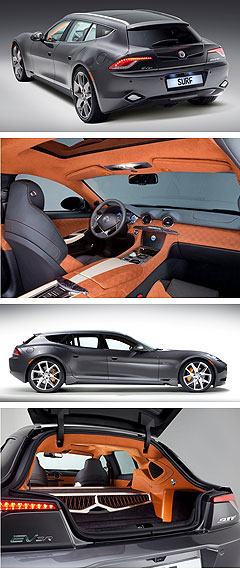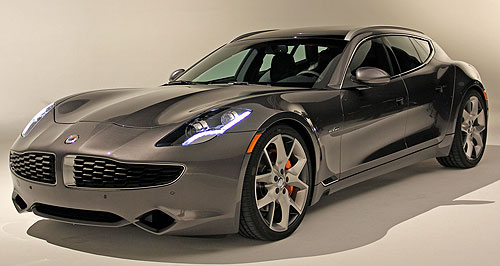Future models - Fisker - Surf - wagonFrankfurt show: Fisker Surf to set sail in 2012Big ticket: Fisker’s shooting brake-style Surf might resemble the Ferrari FF, but its designer considers it to be “perhaps the most elegant production sport wagon ever made”. Luxury hybrid sports wagon from Fisker Automotive to enter production next year14 Sep 2011 By TERRY MARTIN FISKER Automotive has confirmed that the plug-in hybrid Surf wagon unveiled at the Frankfurt motor show this week will enter production in the first half of next year, providing the Californian-based eco-prestige marque with a practical ‘shooting brake’-style vehicle to sell alongside the Karma sedan on which it is based. Drawing inspiration from the 1970s Lamborghini Espada but creating a stir with similarities to Ferrari’s new FF – albeit with four doors – chief designer and CEO Henrik Fisker, who before striking out on his own in 2007 had sculpted the Aston Martin V8 Vantage and BMW Z8, said the Surf was two years in the making and had turned out as “perhaps the most elegant production sport wagon ever made”. “With the Surf, Fisker has created a unique cross between a luxury sportscar and a station wagon,” he said. “The Surf is a first-of-its-kind eco-friendly lifestyle vehicle that offers space, performance and luxury design for people who live an active, environmentally conscious lifestyle and like to drive beautiful cars.” Like the Karma, the Surf – so named, at least in part, because a surfboard can be strapped onto the roof – will be built in Finland by contract manufacturer Valmet Automotive and sold as a left-hand-drive-only model in key markets across the globe, with Europe identified as its main target.  Pricing is still to be announced, but the Surf is expected to attract a premium over the circa-$100,000 Karma. Pricing is still to be announced, but the Surf is expected to attract a premium over the circa-$100,000 Karma.The company said the Surf would be launched for the 2013 model year, creating a new niche and opening new customer markets for the marque “by appealing to those looking for this unique blend of advanced technology, innovative design and environmental sensitivity, with added versatility”. As expected, the Surf uses the same ‘Q-Drive’ range-extending plug-in hybrid powertrain as in the Karma, driving the rear wheels via two 150kW electric motors mounted on the rear differential, a 20kWh lithium-ion battery pack and a 194kW 2.0-litre four-cylinder turbo-petrol engine that acts as a generator. As with the Karma, the Surf can accelerate from 0-100km/h in a claimed 5.9 seconds, on its way to a top speed of 201km/h. Its maximum all-electric range is 80km, with the combustion engine enabling a further 403km before refuelling/recharging is required. The latter takes 14 hours via a standard 110-volt household supply in the US, or six hours on a 220-volt Euro-spec outlet. Production of a convertible version of the Karma, which was shown in concept form at the 2009 Detroit motor show, is still to be confirmed, with the striking shooting brake model now overtaking it as the next model built off the platform. Mr Fisker said in Frankfurt this week that a more versatile variant became part of the model program “very early in the development of the original Karma sedan” and that preliminary work began on the Surf mid-2009, when the sedan’s design was locked in. The company maintains that “a five-door vehicle has never looked this sporty”, pointing to its “voluptuous sculptured rear fenders and dynamic side profile”. The overall stance and dimensions of the Surf are unchanged from those of the Karma sedan, although the extended roofline and side glass make the wagon appear longer and sleeker. Other reference points include the aerodynamically optimised tailgate, integrated roof rails, a neatly integrated rear brake light that is “nearly invisible” until it illuminates, an “artfully incorporated” roof spoiler, a unique two-colour design for the massive 22-inch wheels (the same size as Karma’s), a new three-dimensional honeycomb-pattern grille and a tinted panoramic roof panel that can be tilted open at the back for increased ventilation. An optional see-through solar-electric roof panel can also be ordered. As seen on the Karma, the Surf’s cabin is swathed in ‘low-carbon’ leather sourced from a low-emissions and energy self-sufficient tannery in Scotland, while ‘animal-free’ materials can be specified and the wood veneer comes from “sunken logs and fire-damaged trees, not cut from living forests”. Recycled materials are also used for seat cushions, carpet backing and various trim pieces. Despite the Surf’s practical nature, Mr Fisker said a “strong sense of luxury and style” was worked into the interior design, which includes the company’s signature diamond motifs and a high attention to detail, such as a “richly crafted” cast-aluminium divider in the luggage compartment. The cargo area is divided into three areas: the main boot for large items a raised shelf (dubbed the ‘podium’) for smaller objects, which makes use of an area constrained by the electric powertrain’s large under-floor invertors and an extended load space that comes into play when the individual rear seatbacks are folded. A centre console between the rear seats, under which the vehicle’s main battery is located, also incorporates an additional storage bin. Compared to the sedan, the Surf is said to offer significantly more rear headroom due to the higher roofline and the absence of a headliner under the tinted glass or solar-electric roof panels. The larger side window areas also allow improved outward visibility.  Read more9th of September 2011  Frankfurt show: Surf’s up at Fisker AutomotiveKarma-based plug-in hybrid fastback in works as Fisker signs engine deal with BMW1st of August 2011  BMW reveals i8 hybrid supercarDesign chief promises eye-catching BMW supercar will stay true to concept19th of February 2010  Fisker Karma EV to offer ‘world-class’ dynamicsFisker Automotive promises a supercar-like experience from forthcoming Karma EV16th of January 2009 Detroit show: Fisker gets friskySleek metal-roofed convertible joins eco-friendly Fisker sedan as production loomsAll future models Alfa Romeo Alfa Romeo Abarth Abarth Audi Audi Aston Martin Aston Martin BMW BMW Bentley Bentley Chrysler Chrysler Chevrolet Chevrolet Dodge Dodge Citroen Citroen Ferrari Ferrari DS DS Ford Ford Fiat Fiat FPV FPV Foton Foton Haval Haval Great Wall Great Wall Honda Honda Holden Holden Hyundai Hyundai HSV HSV Isuzu Isuzu Infiniti Infiniti Jeep Jeep Jaguar Jaguar Lamborghini Lamborghini Kia Kia Lexus Lexus Land Rover Land Rover Mazda Mazda Maserati Maserati Mercedes-Benz Mercedes-Benz McLaren McLaren Mini Mini Nissan Nissan Mitsubishi Mitsubishi Peugeot Peugeot Opel Opel Proton Proton Porsche Porsche Renault Renault Ram Ram Saab Saab Rolls-Royce Rolls-Royce Smart Smart Skoda Skoda Subaru Subaru SsangYong SsangYong Tesla Tesla Suzuki Suzuki Toyota Toyota Volvo VolvoMotor industry news |
Click to shareFisker modelsResearch Fisker All future models Alfa Romeo Alfa Romeo Abarth Abarth Audi Audi Aston Martin Aston Martin BMW BMW Bentley Bentley Chrysler Chrysler Chevrolet Chevrolet Dodge Dodge Citroen Citroen Ferrari Ferrari DS DS Ford Ford Fiat Fiat FPV FPV Foton Foton Haval Haval Great Wall Great Wall Honda Honda Holden Holden Hyundai Hyundai HSV HSV Isuzu Isuzu Infiniti Infiniti Jeep Jeep Jaguar Jaguar Lamborghini Lamborghini Kia Kia Lexus Lexus Land Rover Land Rover Mazda Mazda Maserati Maserati Mercedes-Benz Mercedes-Benz McLaren McLaren Mini Mini Nissan Nissan Mitsubishi Mitsubishi Peugeot Peugeot Opel Opel Proton Proton Porsche Porsche Renault Renault Ram Ram Saab Saab Rolls-Royce Rolls-Royce Smart Smart Skoda Skoda Subaru Subaru SsangYong SsangYong Tesla Tesla Suzuki Suzuki Toyota Toyota Volvo VolvoMotor industry news |
















Facebook Twitter Instagram